Overview
Navigating the VA disability rating process for hypertension can feel overwhelming. We understand that many veterans face challenges in securing the benefits they deserve. This article sheds light on how AI technology can streamline claims, the essential medical documentation needed, and the impact of lifestyle factors on your health.
By grasping the specific rating criteria and keeping thorough documentation, you can significantly improve your chances of receiving benefits. Remember, you are not alone in this journey; there are resources available to support you. Together, we can enhance your overall experience in the claims process.
It's common to feel uncertain, but with the right understanding and preparation, you can take confident steps forward. We’re here to help you navigate this path and ensure your voice is heard.
Introduction
Navigating the complexities of VA disability ratings for hypertension can feel overwhelming for many veterans. We understand that the stakes are high, and grasping the intricacies of the claims process is essential for securing the benefits you deserve. In this article, we explore ten key insights designed to illuminate your path toward a successful VA disability rating for hypertension.
We will highlight the critical role of technology, lifestyle factors, and the necessary documentation to support your claims.
How can you, as a veteran, effectively leverage these insights to overcome common challenges and ensure your health and well-being are prioritized in the claims process? You're not alone in this journey, and we're here to help.
Turnout: Streamlining VA Disability Claims for Hypertension
Turnout is transforming the environment for former service members pursuing a VA disability rating for hypertension by harnessing the power of AI technology. This innovative approach significantly reduces bureaucratic delays and enhances communication, allowing veterans to navigate the complexities of their applications with ease. With the support of Turnout's community, veterans can ensure they receive the benefits they deserve without the added stress typically associated with the application process.
The integration of AI in VA disability application processing has led to remarkable improvements. For instance, the average processing time for disability-related requests has dropped to 94.8 days, reflecting a 17.8% increase in efficiency compared to the previous fiscal year. This progress is largely due to AI tools that simplify administrative tasks, enabling professionals to concentrate on critical decision-making.
Organizations like Turnout illustrate how technology can enhance the experience for former service members. By providing real-time status updates and streamlining documentation, Turnout empowers veterans to manage their requests effectively. This is particularly vital for those dealing with hypertension, as timely access to benefits can profoundly influence their quality of life.
Veterans have expressed their gratitude for these advancements, noting that the simplified procedures have alleviated much of the anxiety associated with submitting requests. As one veteran shared, the support from organizations utilizing AI has made navigating the benefits system feel less daunting, allowing them to focus on their well-being and recovery.
Overall, Turnout's commitment to leveraging AI technology not only enhances the efficiency of the claims process but also enriches the overall experience for those seeking a VA disability rating for hypertension. Remember, you are not alone in this journey, and we are here to help you every step of the way.
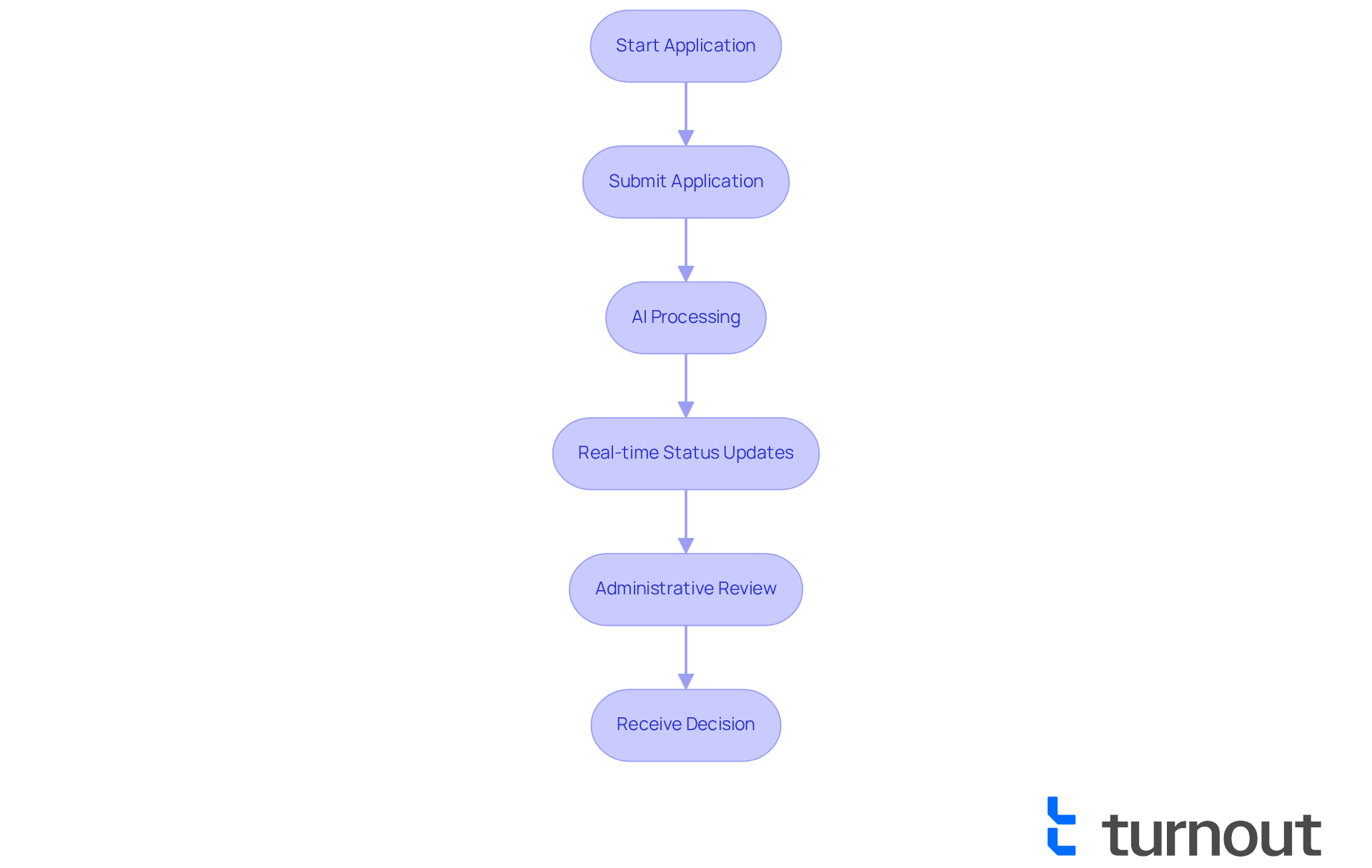
VA Disability Rating Criteria for Hypertension: Key Requirements
To qualify for a VA disability rating for hypertension, veterans need to provide comprehensive medical evidence that aligns with specific rating criteria established by the VA. This includes:
- A current medical diagnosis
- Several blood pressure readings taken on at least three distinct days
- A thorough nexus letter linking their condition to military service
Hypertension is typically assessed based on blood vessel measurements and symptom intensity. A 10% rating is assigned when the diastolic level is 100 or greater, with higher ratings available for more severe conditions—such as a 20% rating for diastolic levels predominantly at 110 or above. Veterans with high blood pressure may also be eligible for a 0% rating, which establishes service connection and allows for future requests if their condition worsens or if they want to pursue secondary conditions related to high blood pressure.
We understand that navigating this process can feel overwhelming. Real-world examples highlight the importance of thorough documentation. For instance, one individual who initially received a noncompensable rating successfully appealed for a 10% rating after providing detailed blood pressure logs and medical evaluations. It's common to feel uncertain, but former service members are encouraged to maintain documentation of how hypertension impacts their daily lives. This information can significantly bolster their cases. Recording any worsening symptoms and obtaining updated medical assessments are vital steps in supporting their requests.
Comprehending these criteria is crucial for former service members to effectively advocate for their claims related to the VA disability rating for hypertension. The VA emphasizes the need for consistent blood pressure readings taken on at least three separate days to confirm a diagnosis. By fulfilling these requirements and providing a comprehensive nexus letter linking their condition to military service, former service members can enhance their chances of obtaining the appropriate disability rating. Additionally, those whose high blood pressure greatly affects their ability to work might consider seeking Total Disability Individual Unemployability (TDIU) requests, which can provide extra financial support. Remember, you are not alone in this journey; we’re here to help.
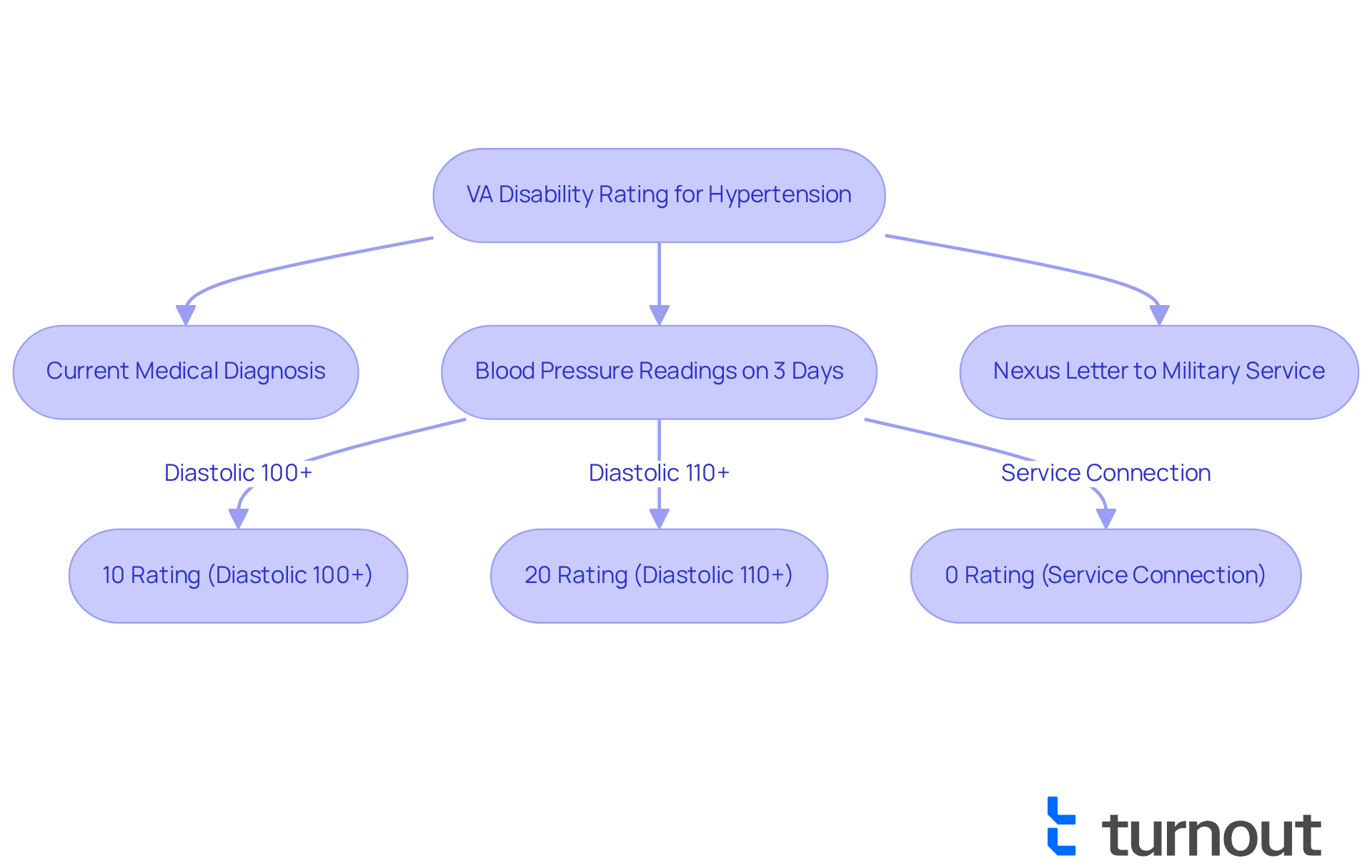
Secondary Conditions Associated with Hypertension: What Veterans Should Know
Veterans with hypertension often face additional challenges, including heart disease, kidney problems, or stroke. These secondary conditions can profoundly impact your quality of life. It's important to recognize that these issues may also play a crucial role in your claims for a VA disability rating for hypertension. We understand that navigating these complexities can be overwhelming.
It is essential to document any secondary conditions when assessing the VA disability rating for hypertension. By discussing these with your advocates, you ensure a thorough evaluation of your overall health status. Remember, you are not alone in this journey. We’re here to help you every step of the way. Taking these actions can lead to better support and resources for your needs.

Presumptive Service Connection for Hypertension: Eligibility Insights
Veterans, we understand that navigating the complexities of service connection for high blood pressure and achieving a VA disability rating for hypertension can be challenging. If you served in specific locations or under certain conditions, particularly those involving exposure to Agent Orange, you may qualify for presumptive service connection. This classification allows you to bypass the often intricate requirement of proving a direct link between your high blood pressure and military service, making the claims process easier.
Research indicates that approximately 81.6% of former military personnel who applied herbicides in Vietnam reported elevated blood pressure. This statistic highlights the significant connection between Agent Orange exposure and high blood pressure. However, it's important to clarify that the VA does not currently recognize high blood pressure as a presumptive condition for those exposed to herbicides. Nevertheless, they do provide treatment for high blood pressure regardless of exposure.
We encourage you to consult with your advocates to determine if you meet the eligibility criteria for presumptive service connection. Understanding your options related to the VA disability rating for hypertension can significantly impact your claims and potential benefits. Remember, you are not alone in this journey; we are here to help you every step of the way.
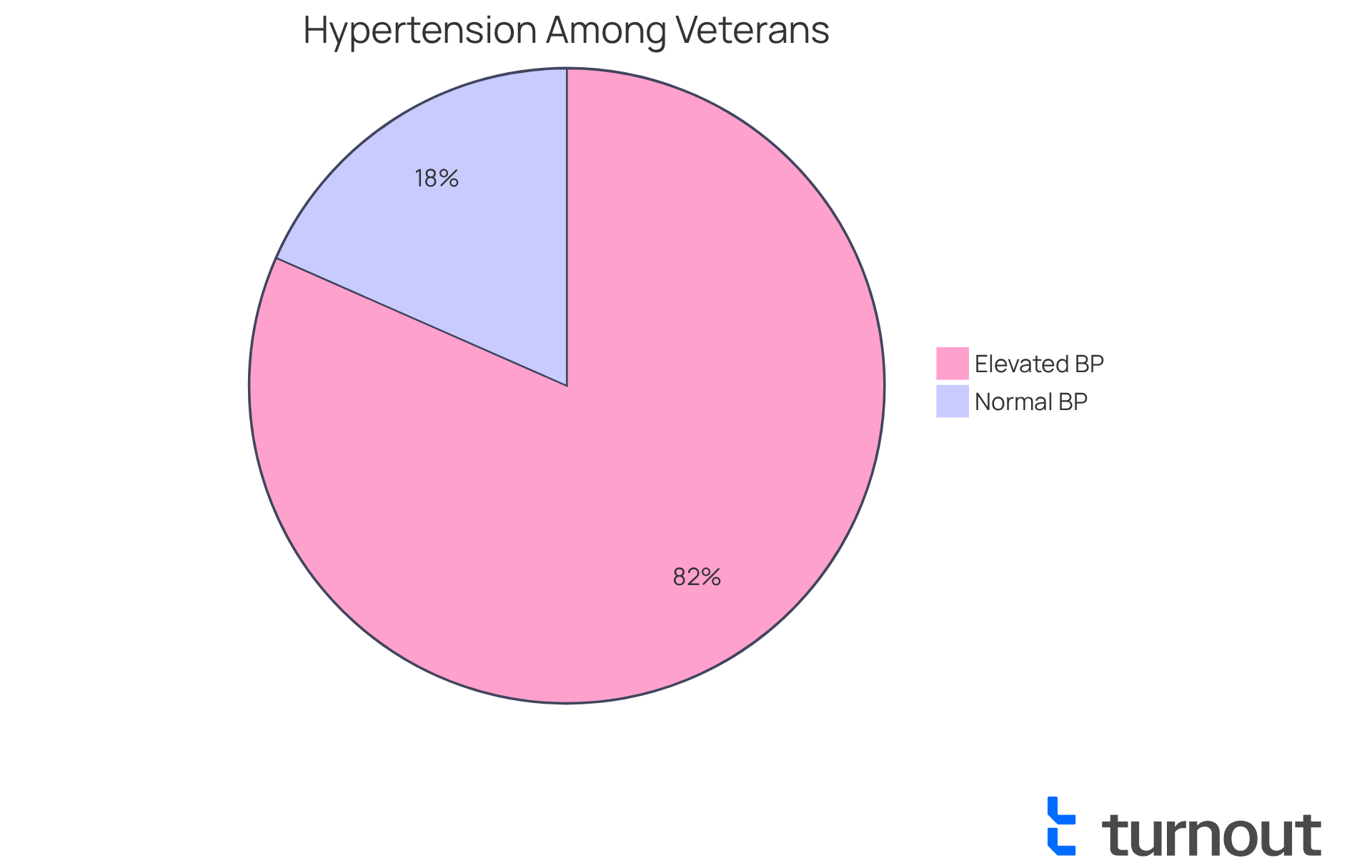
Impact of Lifestyle on VA Disability Ratings for Hypertension
Lifestyle elements such as nutrition, physical activity, and stress control are crucial in managing high blood pressure, especially for our former service members. We understand that making healthy lifestyle choices can lead to significant improvements in health outcomes, which may positively influence one's VA disability rating for hypertension. For instance, veterans who embrace a balanced diet and engage in regular physical activity often experience reductions in blood pressure, which can positively influence their VA disability rating for hypertension. Health professionals emphasize that lifestyle adjustments are essential for managing high blood pressure. As Maciej Tomaszewski highlights, 'The significance of lifestyle modifications in both treatment and prevention of high blood pressure is further underscored.'
Veterans, we encourage you to carefully document any lifestyle changes and their effects on your hypertension when submitting requests. This documentation can serve as compelling evidence to support your case, showcasing a proactive approach to managing your health. Furthermore, research indicates that weight reduction and dietary changes—such as decreasing sodium intake, a major dietary risk factor for hypertension—can significantly lower blood pressure levels, thereby enhancing the chances of receiving a favorable VA disability rating for hypertension. By prioritizing your health through lifestyle changes, you not only improve your well-being but also strengthen your requests for benefits. The theme for World Hypertension Day 2024, 'Measure Your Blood Levels Accurately, Control It, Live Longer,' highlights the importance of monitoring blood pressure in relation to lifestyle changes.

Steps to File a VA Claim for Hypertension: A Comprehensive Guide
Filing a VA claim for hypertension can feel overwhelming, but we're here to guide you through the essential steps to ensure a smoother process:
- Gather comprehensive medical records that document your hypertension diagnosis, including blood pressure readings and treatment history.
- Complete the VA Form 21-526EZ, which is the Application for Disability Compensation. This form is crucial for starting your request.
- Submit your request either online through the VA's website or by mail to your local VA office.
- Attend any scheduled Compensation and Pension (C&P) exams, where your condition will be assessed to determine the appropriate disability rating.
- Consistently check on your status to stay updated about its progress.
By following these steps, veterans can significantly improve the efficiency of their claims process and enhance their chances of receiving the benefits they deserve.
It's essential to recognize that the VA allocates a disability rating for hypertension based on specific readings of elevated blood flow. For instance, a 10% rating is assigned for diastolic pressure predominantly 100 or more, while a 60% rating is given for diastolic pressure predominantly 130 or higher.
We understand that veterans frequently encounter difficulties in establishing a service link for their VA disability rating for hypertension. As one experienced individual observed, 'Submitting a VA disability rating for hypertension can be difficult, particularly regarding the demonstration of service connection and the provision of required medical evidence.'
Moreover, frequent errors involve not offering consistent blood measurements and neglecting to create a clear link to military service. To avoid these pitfalls, former service members should keep a record of their blood pressure readings and consider acquiring a robust nexus letter from a healthcare provider connecting their condition to military service.
By adhering to these guidelines and being mindful of possible obstacles, former service members can navigate the claims process more efficiently. Remember, you are not alone in this journey, and support is available to help you every step of the way.
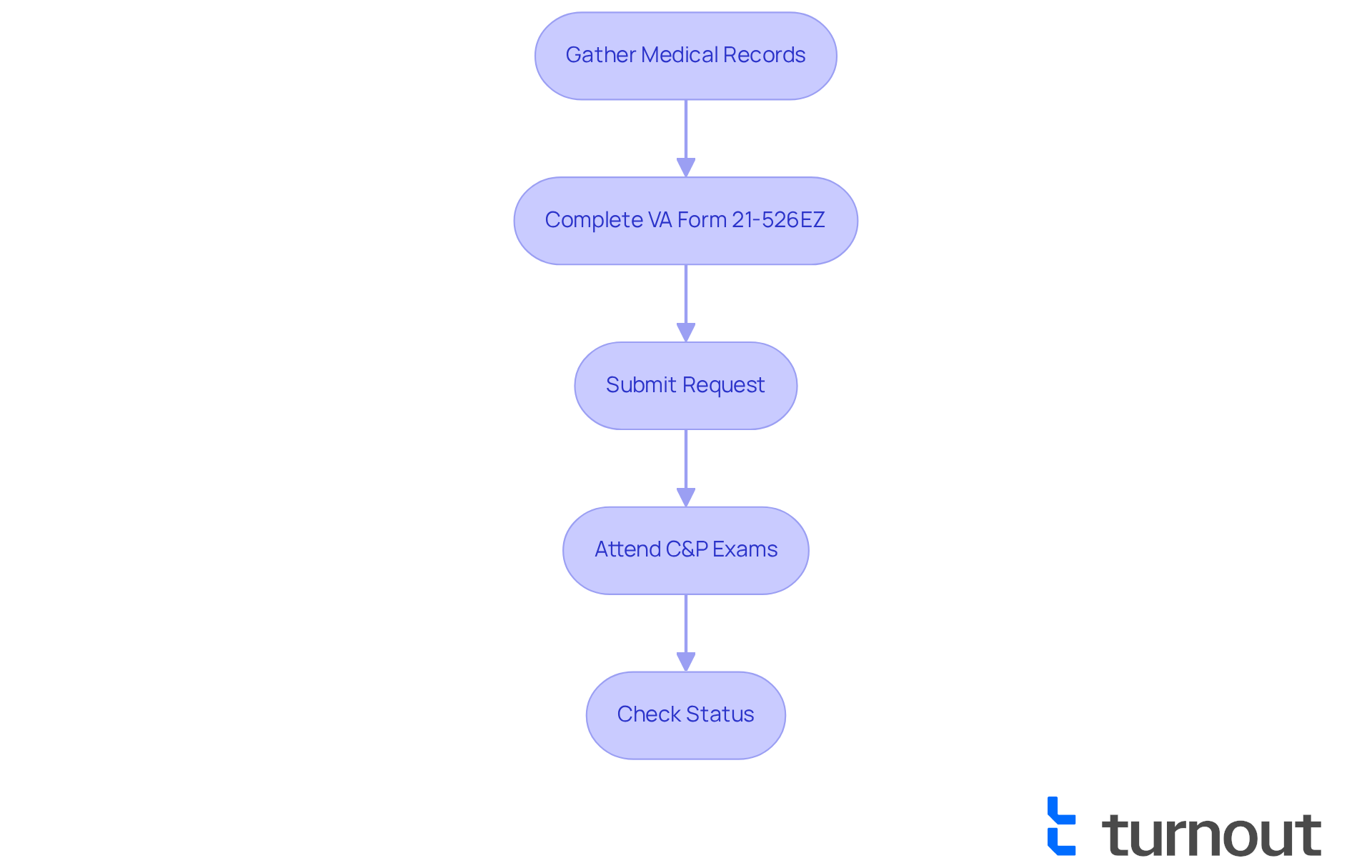
C&P Exam for Hypertension: What to Expect and Prepare
We understand that preparing for the Compensation and Pension (C&P) examination to obtain a VA disability rating for hypertension can feel overwhelming. During this important assessment, your medical history and current health condition will be thoroughly evaluated. The examiner will measure your blood circulation and inquire about your symptoms and treatment history.
To ensure a comprehensive assessment, it’s crucial to gather all relevant medical records. This includes:
- A detailed list of your medications
- Being ready to discuss how hypertension affects your daily life
This preparation is vital, as consistent blood flow readings are essential for establishing a strong case.
Consider keeping a home record of your blood readings. This can provide a clear pattern of your condition, significantly impacting the outcome of your claim. Additionally, bringing past blood pressure readings from healthcare visits can strengthen your case, as the C&P exam typically relies on a single reading that may not fully reflect your overall health.
By being well-prepared, you can enhance your chances of receiving an accurate and favorable evaluation for your VA disability rating for hypertension during the C&P exam. Remember, you are not alone in this journey, and we’re here to help you through it.
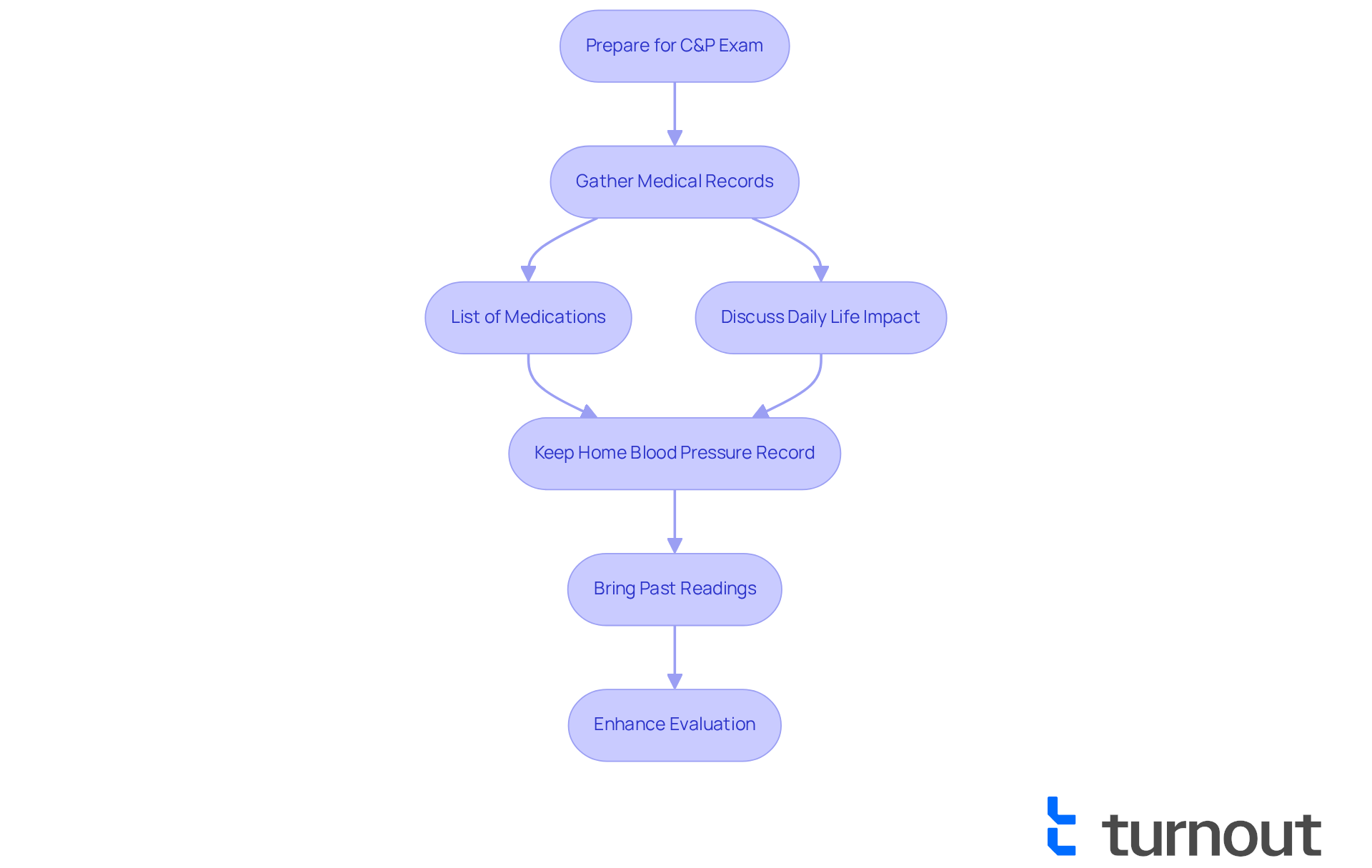
Tips to Strengthen Your VA Claim for Hypertension
We understand that navigating a VA disability rating for hypertension can be challenging. To enhance your claim, consider these essential tips:
-
Ensure all medical documentation is thorough and current. A lack of evidence is a common reason for claim denials, and we want to help you avoid that.
-
Clearly express how high blood pressure impacts your daily life and your ability to work. Personal impact statements can significantly affect the evaluation process.
-
Link your hypertension to any in-service events, exposures, or injuries. This connection is crucial for establishing service connection, and we’re here to guide you through it.
-
Attend a Compensation and Pension (C&P) examination. This assessment is vital for securing the VA disability rating for hypertension and other VA disability benefits, and your participation is essential.
-
Seek help from professionals who specialize in navigating the claims process. Their expertise can provide valuable support in understanding the intricacies of your case.
-
Acquire a personal statement from a healthcare provider that outlines your condition and its implications. This can improve the credibility of your request.
Implementing these strategies can greatly strengthen your claim for a VA disability rating for hypertension. Remember, you are not alone in this journey; we are here to help you every step of the way.
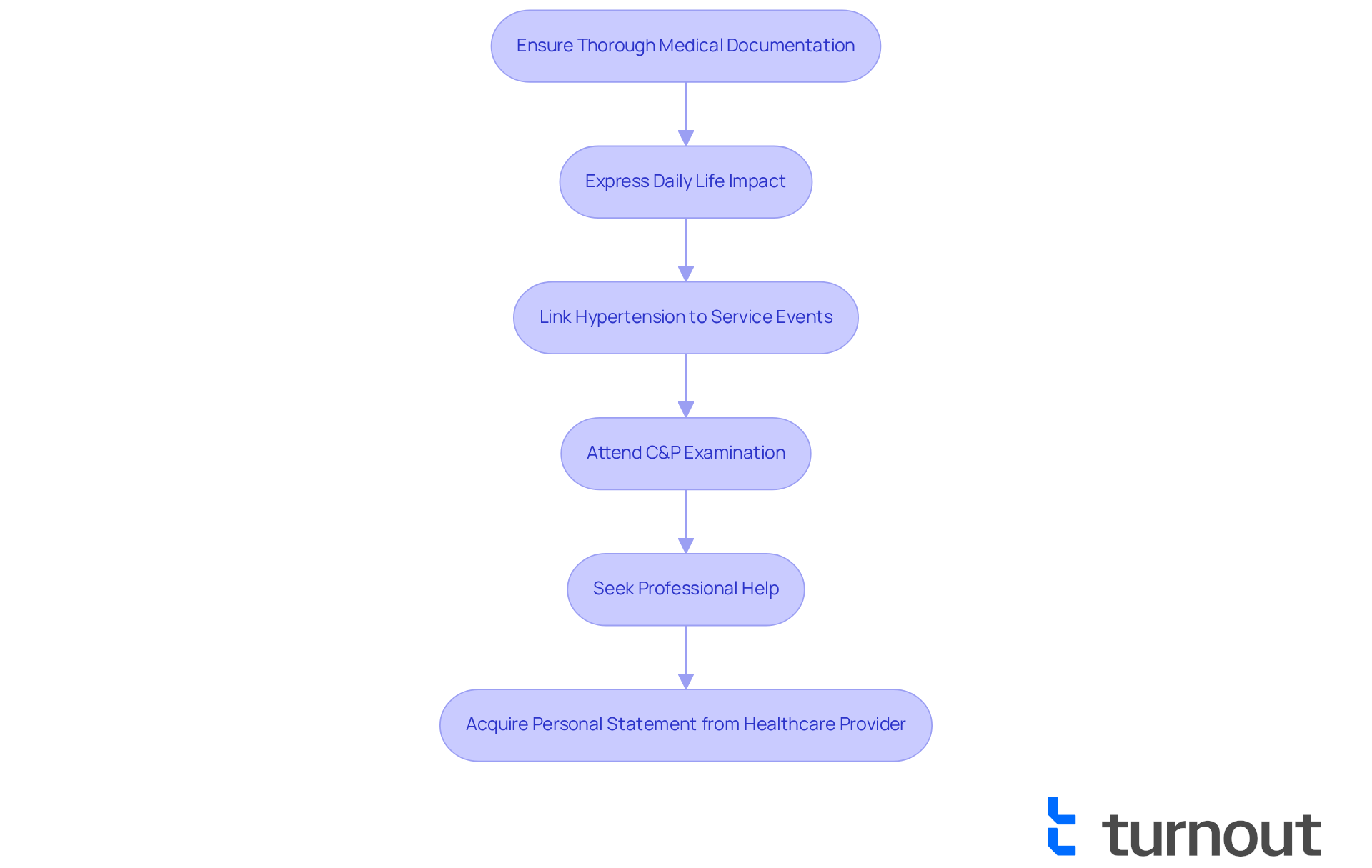
Common Misconceptions About VA Disability Ratings for Hypertension
Misunderstandings regarding VA disability rating for hypertension are common among veterans, and we understand how frustrating this can be. Many believe that only serious cases justify benefits, overlooking the fact that even mild high blood pressure can be considered if it impacts daily activities. For instance, a 10% rating may be granted for diastolic levels primarily at 100 or above, or systolic levels at 160 or more, especially if ongoing medication is necessary.
It's important to note that the average VA disability rating for hypertension typically ranges from 0-10%. This reflects the common necessity for continuous medication and moderate blood pressure elevation. Additionally, lifestyle choices play a crucial role in managing blood pressure and may even enhance ratings.
Veterans who have successfully navigated the application process often share that understanding these nuances has empowered them to pursue their requests more effectively. One veteran expressed, 'I believed my mild blood pressure issue wouldn’t meet the criteria, but once I understood the evaluations, I recognized I had a legitimate case.'
For those exposed to Agent Orange, it’s reassuring to know that the VA disability rating for hypertension is recognized as a presumptive condition, which can simplify the benefits process. To strengthen their claims, veterans should ensure they obtain blood pressure measurements on at least three different days to confirm a current diagnosis.
By dispelling these myths and gathering the necessary documentation, you can better advocate for yourself and secure the benefits you deserve. Remember, you are not alone in this journey, and we are here to help you every step of the way.

Resources for Veterans Seeking Help with Hypertension Claims
If you're a veteran seeking assistance with claims related to VA disability rating for hypertension, you're not alone. Many veterans face challenges in navigating this process, but there are valuable resources available to help you.
-
Consider visiting the VA's official website. It offers extensive information on benefits and the application process, making it a great starting point.
-
Reach out to Veteran Service Organizations (VSOs). These organizations provide complimentary, expert support with applications, significantly enhancing your chances of success. In fact, numerous former service members have reported greater approval rates when collaborating with VSOs rather than filing on their own.
-
You might also find comfort in online forums and support groups. These platforms allow former military members to exchange experiences, guidance, and tactics for managing the application process together.
-
Additionally, Turnout's advocacy services offer tailored assistance to help you efficiently handle your requests and understand your rights.
By leveraging these resources, you can significantly improve your capacity to submit your request effectively and obtain the benefits you deserve. With the VA's recent recognition of hypertension as a presumptive condition for those exposed to Agent Orange, it’s crucial to understand the VA disability rating for hypertension and take timely and informed action. Remember, you're not alone in this journey, and we're here to help you navigate through it.
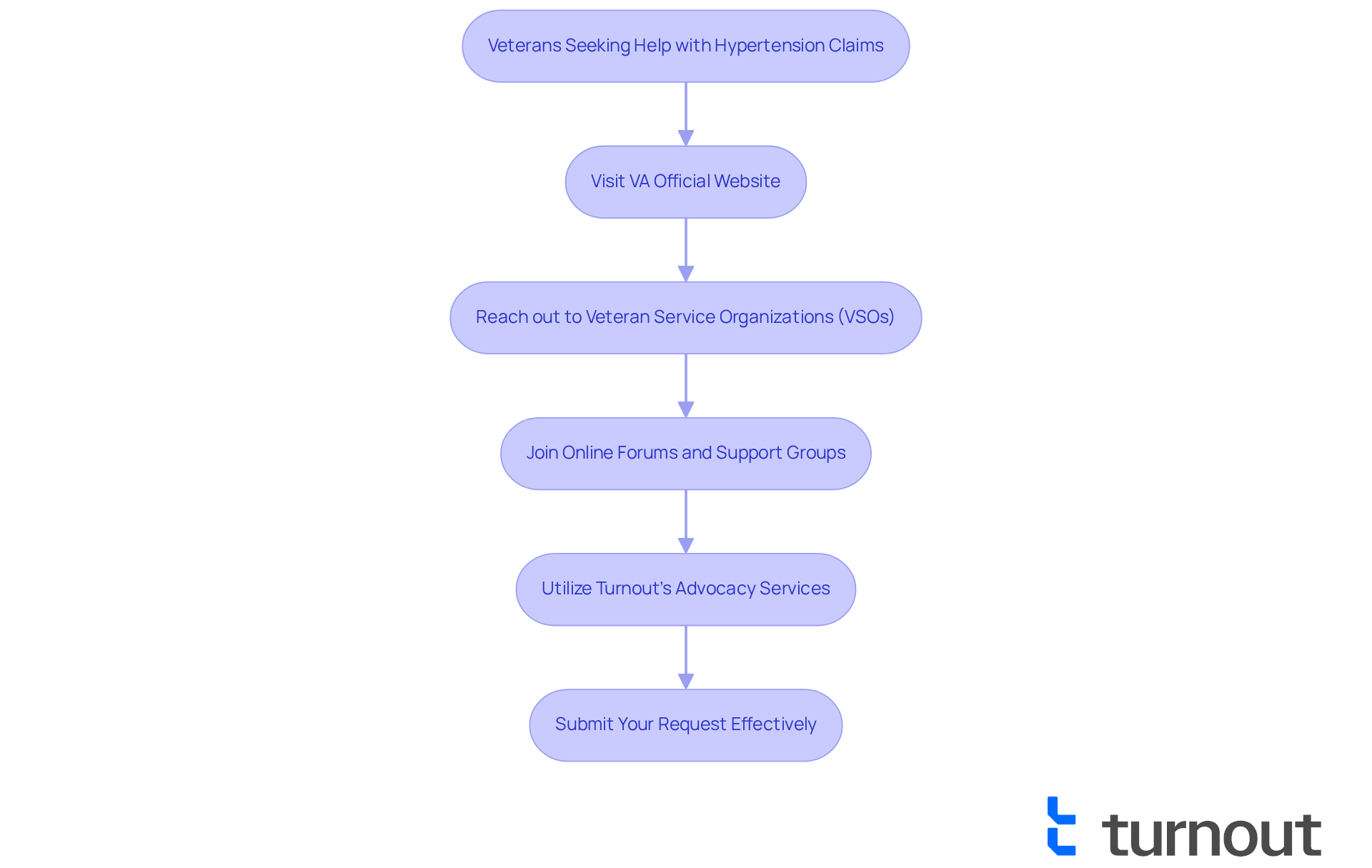
Conclusion
Turnout's innovative approach to streamlining the VA disability rating process for hypertension represents a significant advancement for veterans seeking the benefits they deserve. By integrating AI technology, the organization not only enhances the efficiency of claims processing but also alleviates the stress associated with navigating complex bureaucratic systems. This transformation empowers veterans, providing them with timely access to crucial support that can greatly improve their quality of life.
We understand that navigating the VA disability rating system can be challenging. Throughout this article, we've shared key insights regarding the requirements for obtaining a VA disability rating for hypertension. This includes:
- The importance of comprehensive medical documentation
- The impact of lifestyle choices
- The potential for secondary conditions
Additionally, grasping the nuances of presumptive service connection and the steps to file a claim can significantly influence the approval process. Veterans are encouraged to leverage available resources, including professional advocacy services and community support, to bolster their claims effectively.
Ultimately, you are not alone in this journey. By embracing the resources and guidance available, veterans can take proactive steps to advocate for their health and well-being. The message is clear: understanding the intricacies of the claims process, coupled with the right support, can lead to successful outcomes and a brighter future for those affected by hypertension.
Frequently Asked Questions
How is Turnout improving the VA disability claims process for hypertension?
Turnout is utilizing AI technology to streamline the VA disability claims process for hypertension, reducing bureaucratic delays and enhancing communication, which helps veterans navigate their applications more easily.
What impact has AI had on the processing time for VA disability claims?
The integration of AI has led to a significant reduction in the average processing time for disability-related requests, which now stands at 94.8 days, reflecting a 17.8% increase in efficiency compared to the previous fiscal year.
What are the key requirements for veterans to qualify for a VA disability rating for hypertension?
Veterans must provide a current medical diagnosis, several blood pressure readings taken on at least three distinct days, and a thorough nexus letter linking their condition to military service.
How is hypertension rated by the VA?
Hypertension is rated based on blood vessel measurements and symptom intensity. A 10% rating is assigned for diastolic levels of 100 or greater, with higher ratings available for more severe conditions, such as 20% for diastolic levels predominantly at 110 or above.
Can veterans with high blood pressure receive a 0% rating?
Yes, veterans with high blood pressure can receive a 0% rating, which establishes service connection and allows for future requests if their condition worsens or if they wish to pursue secondary conditions related to high blood pressure.
What should veterans do to support their VA disability claims for hypertension?
Veterans should maintain thorough documentation of their blood pressure readings, symptoms, and how hypertension impacts their daily lives. Updated medical assessments and detailed blood pressure logs can significantly strengthen their claims.
What are some common secondary conditions associated with hypertension that veterans should be aware of?
Common secondary conditions include heart disease, kidney problems, and stroke. Documenting these conditions is important when assessing the VA disability rating for hypertension.
What can veterans do if their hypertension significantly affects their ability to work?
Veterans whose hypertension greatly impacts their ability to work might consider seeking Total Disability Individual Unemployability (TDIU) requests for additional financial support.




